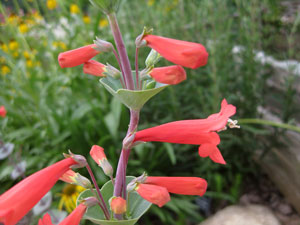Resource Library
Plant of the Week: Scarlet Penstemon
The University of Arkansas System Division of Agriculture does not promote, support or recommend plants featured in "Plant of the Week." Please consult your local Extension office for plants suitable for your region.
Plant of the Week
Scarlet Penstemon
Latin: Penstemon murrayanus

Wildflowers have great appeal amongst gardeners yet, as a class of plants, they remain marginalized by the nursery and greenhouse trade.
Then when the trade finally accepts that a wildflower has commercial appeal, such as it has have recently done with Echinacea, or purple coneflower, the trade mucks it up by creating lavish and unnatural hybrids that provide an impressive display by abolishing the natural charm of the species. The scarlet penstemon, Penstemon murrayanus, is an uncommon Arkansas native that has considerable garden potential, but let’s hope breeders leave its basic look alone and only focus on making it easier to grow.
Penstemon murrayanus is one of six species of Penstemons native to Arkansas. Penstemon is a North American genus now, based on DNA studies, classified as belonging to the Plantain family. It consists of more than 250 species with the center of distribution being in the Southwestern states and Mexico. Scarlet penstemon is found in two counties in Arkansas as well as in Louisiana, Texas and Oklahoma where it grows in sandy soils and is often at the edge of a pine grove or in a prairie setting.
This is a large penstemon growing 5 to 6 feet tall with a basal rosette of glaucous gray leaves that send up upright stems bearing scarlet or orange-red flowers in late spring and summer. The oppositely arranged stem leaves are joined at the base -- called perfoliate arrangement -- to form a kind of cup, a characteristic that is unique to this species.
At the top of the stems the cupped leaves produce from two to five 1.5-inch long tubular red to red-orange flowers. The principle pollinator for this plant is the ruby throated hummingbird. Scarlet penstemon has an indeterminate inflorescence that continues to elongate as long as growing conditions are suitable. The ever-lengthening inflorescence sometimes gets too long for the stem to support and the plant begins to sprawl as the season progresses.
The genus penstemon was first described by John Mitchell (1711-1768), a Virginia-born geographer and botanist who first described the genus in 1748. Scarlet penstemon was named after the Scottish botanist and conifer expert Andrew Murray (1812 – 1878). P. murrayanus was grown as early as the 1830s in England where chroniclers reported it as rare in cultivation because there wasn’t enough heat in a British summer to ripen seeds and the plants were prone to die during the “winter wets.” It is still rare in American gardens but occasionally seeds will become available or some native plant nurseries offer it.
In the garden, this penstemon should be grown in full sun in an open position where it does not have to compete with the foliage of larger growing perennials. It is best in full sun but will tolerate light shade where its floppy ways will be more evident. It needs good drainage in winter and, though it is usually found in sandy soils, will grow in loamy soils provided drainage is good. Once established it is drought tolerant. We have grown it for the past five years at the Botanical Garden of the Ozarks in our native garden in soils that are heavier than those described above and it seems to be doing just fine.
This would make a great plant for improvement by breeding but instead of “improving” the flowers by introducing unusual color combinations, the breeders should focus their attention on creating a slightly more compact plant with better tolerance of normal garden conditions.
By: Gerald Klingaman, retired
Retired Extension Horticulturist - Ornamentals
Extension News - May 25, 2012
The University of Arkansas System Division of Agriculture does not maintain lists of retail outlets where these plants can be purchased. Please check your local nursery or other retail outlets to ask about the availability of these plants for your growing area.